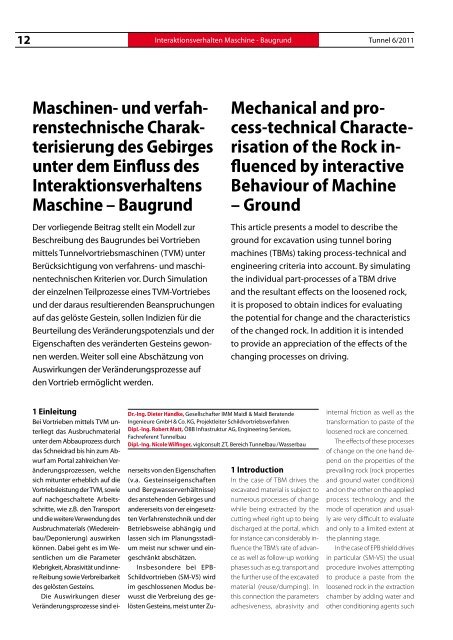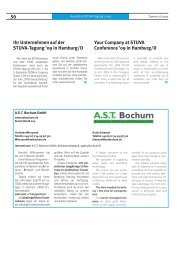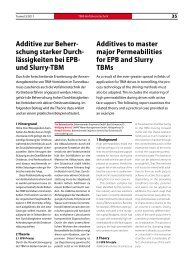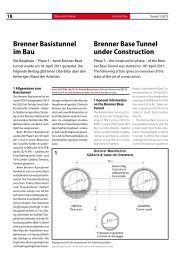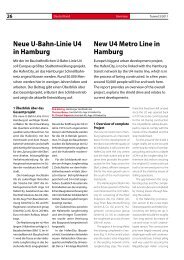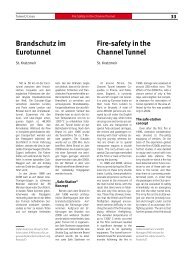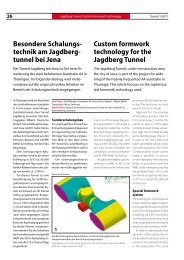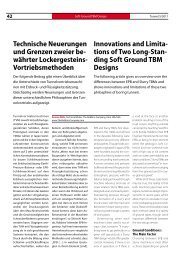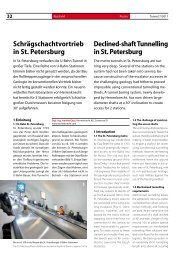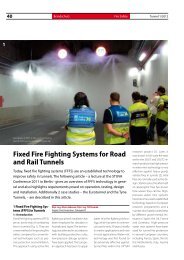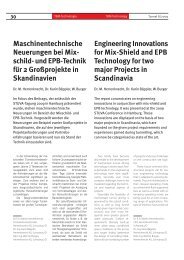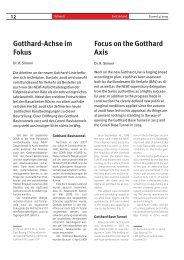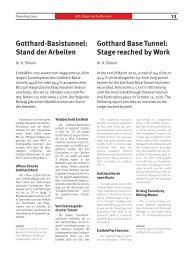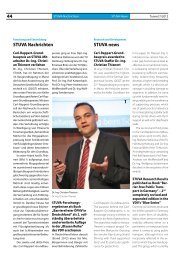Maschinen- und verfah- renstechnische Charak- terisierung ... - Tunnel
Maschinen- und verfah- renstechnische Charak- terisierung ... - Tunnel
Maschinen- und verfah- renstechnische Charak- terisierung ... - Tunnel
Sie wollen auch ein ePaper? Erhöhen Sie die Reichweite Ihrer Titel.
YUMPU macht aus Druck-PDFs automatisch weboptimierte ePaper, die Google liebt.
12 Interaktionsverhalten Maschine - Baugr<strong>und</strong> <strong>Tunnel</strong> 6/2011<br />
<strong>Maschinen</strong>- <strong>und</strong> <strong>verfah</strong><strong>renstechnische</strong><br />
<strong>Charak</strong><strong>terisierung</strong><br />
des Gebirges<br />
unter dem Einfluss des<br />
Interaktionsverhaltens<br />
Maschine – Baugr<strong>und</strong><br />
Der vorliegende Beitrag stellt ein Modell zur<br />
Beschreibung des Baugr<strong>und</strong>es bei Vortrieben<br />
mittels <strong>Tunnel</strong>vortriebsmaschinen (TVM) unter<br />
Berücksichtigung von <strong>verfah</strong>rens- <strong>und</strong> maschinentechnischen<br />
Kriterien vor. Durch Simulation<br />
der einzelnen Teilprozesse eines TVM-Vortriebes<br />
<strong>und</strong> der daraus resultierenden Beanspruchungen<br />
auf das gelöste Gestein, sollen Indizien für die<br />
Beurteilung des Veränderungspotenzials <strong>und</strong> der<br />
Eigenschaften des veränderten Gesteins gewonnen<br />
werden. Weiter soll eine Abschätzung von<br />
Auswirkungen der Veränderungsprozesse auf<br />
den Vortrieb ermöglicht werden.<br />
Mechanical and process-technical<br />
Characterisation<br />
of the Rock influenced<br />
by interactive<br />
Behaviour of Machine<br />
– Gro<strong>und</strong><br />
This article presents a model to describe the<br />
gro<strong>und</strong> for excavation using tunnel boring<br />
machines (TBMs) taking process-technical and<br />
engineering criteria into account. By simulating<br />
the individual part-processes of a TBM drive<br />
and the resultant effects on the loosened rock,<br />
it is proposed to obtain indices for evaluating<br />
the potential for change and the characteristics<br />
of the changed rock. In addition it is intended<br />
to provide an appreciation of the effects of the<br />
changing processes on driving.<br />
Dr.-Ing. Dieter Handke, Gesellschafter IMM Maidl & Maidl Beratende<br />
Ingenieure GmbH & Co. KG, Projektleiter Schildvortriebs<strong>verfah</strong>ren<br />
Dipl.-Ing. Robert Matt, ÖBB Infrastruktur AG, Engineering Services,<br />
Fachreferent <strong>Tunnel</strong>bau<br />
Dipl.-Ing. Nicole Wilfinger, viglconsult ZT, Bereich <strong>Tunnel</strong>bau / Wasserbau<br />
1 Einleitung<br />
Bei Vortrieben mittels TVM unterliegt<br />
das Ausbruchmaterial<br />
unter dem Abbauprozess durch<br />
das Schneidrad bis hin zum Abwurf<br />
am Portal zahlreichen Veränderungsprozessen,<br />
welche<br />
sich mitunter erheblich auf die<br />
Vortriebsleistung der TVM, sowie<br />
auf nachgeschaltete Arbeitsschritte,<br />
wie z.B. den Transport<br />
<strong>und</strong> die weitere Verwendung des<br />
Ausbruchmaterials (Wiedereinbau/Deponierung)<br />
auswirken<br />
können. Dabei geht es im Wesentlichen<br />
um die Parameter<br />
Klebrigkeit, Abrasivität <strong>und</strong> innere<br />
Reibung sowie Verbreibarkeit<br />
des gelösten Gesteins.<br />
Die Auswirkungen dieser<br />
Veränderungsprozesse sind einerseits<br />
von den Eigenschaften<br />
(v.a. Gesteinseigenschaften<br />
<strong>und</strong> Bergwasserverhältnisse)<br />
des anstehenden Gebirges <strong>und</strong><br />
andererseits von der eingesetzten<br />
Verfahrenstechnik <strong>und</strong> der<br />
Betriebsweise abhängig <strong>und</strong><br />
lassen sich im Planungsstadium<br />
meist nur schwer <strong>und</strong> eingeschränkt<br />
abschätzen.<br />
Insbesondere bei EPB-<br />
Schildvortrieben (SM-V5) wird<br />
im geschlossenen Modus bewusst<br />
die Verbreiung des gelösten<br />
Gesteins, meist unter Zu-<br />
1 Introduction<br />
In the case of TBM drives the<br />
excavated material is subject to<br />
numerous processes of change<br />
while being extracted by the<br />
cutting wheel right up to being<br />
discharged at the portal, which<br />
for instance can considerably influence<br />
the TBM’s rate of advance<br />
as well as follow-up working<br />
phases such as e.g. transport and<br />
the further use of the excavated<br />
material (reuse/dumping). In<br />
this connection the parameters<br />
adhesiveness, abrasivity and<br />
internal friction as well as the<br />
transformation to paste of the<br />
loosened rock are concerned.<br />
The effects of these processes<br />
of change on the one hand depend<br />
on the properties of the<br />
prevailing rock (rock properties<br />
and gro<strong>und</strong> water conditions)<br />
and on the other on the applied<br />
process technology and the<br />
mode of operation and usually<br />
are very difficult to evaluate<br />
and only to a limited extent at<br />
the planning stage.<br />
In the case of EPB shield drives<br />
in particular (SM-V5) the usual<br />
procedure involves attempting<br />
to produce a paste from the<br />
loosened rock in the extraction<br />
chamber by adding water and<br />
other conditioning agents such
<strong>Tunnel</strong> 6/2011<br />
Interactive Behaviour Machine - Gro<strong>und</strong><br />
13<br />
gabe von Wasser <strong>und</strong> anderen<br />
Konditionierungsmitteln wie<br />
z.B. Schäumen <strong>und</strong> Bentonitsuspensionen,<br />
in der Abbaukammer<br />
angestrebt <strong>und</strong> damit<br />
eine wesentliche Änderung der<br />
Eigenschaften bewirkt.<br />
Bei den Gesteinen zeigen<br />
vor allem Ton-, Schluff- <strong>und</strong><br />
Mergelsteine ein hohes Veränderungspotenzial,<br />
welches<br />
u.a. mit „Wasserlagerungsversuchen“<br />
festgestellt werden soll.<br />
Für die Abschätzung der<br />
<strong>verfah</strong>rensabhängigen Veränderungsprozesse<br />
des gelösten<br />
Gesteins, sowie deren Auswirkungen<br />
auf die einzelnen<br />
Arbeitsschritte der TVM ist die<br />
normative Klassifizierung des<br />
Gebirges nur bedingt ausreichend,<br />
da der wesentliche<br />
Einfluss von Bauart (u.a. Verfahrenstechnik,<br />
Schneidradausbildung)<br />
<strong>und</strong> Betriebsweise<br />
(z.B. Steuerung, Einsatz von<br />
Konditionierungsmitteln) der<br />
TVM, in Baugr<strong>und</strong>ansprachen<br />
im Normalfall noch nicht berücksichtigt<br />
werden kann.<br />
2 Verfahrenstechnisch<br />
relevante Wechselwirkungsmechanismen<br />
Maschine – Baugr<strong>und</strong><br />
Die bedeutenden Wechselwirkungsmechanismen<br />
zwischen<br />
Baugr<strong>und</strong> <strong>und</strong> TVM sind Verschleiß,<br />
Verkleben <strong>und</strong> Verbreibarkeit.<br />
Diese sind von vielen<br />
Einflüssen <strong>und</strong> Parametern<br />
abhängig, die sich nicht in ihrer<br />
Gesamtheit fassen <strong>und</strong> zuordnen<br />
lassen.<br />
2.1 Verschleiß<br />
Als Verschleiß werden oberflächliche<br />
Abnutzungen (Materialverlust)<br />
von <strong>Maschinen</strong>teilen<br />
der TVM infolge von Beanspruchungen<br />
beim Abbau, bei der<br />
Zerkleinerung <strong>und</strong> beim Transport<br />
des Gesteins bezeichnet.<br />
Seitens der Gesteinseigenschaften<br />
wirken sich vor allem<br />
die Härte <strong>und</strong> Festigkeit des Gesteins,<br />
sowie bei Lockergestein<br />
mitunter auch die Kornverteilung,<br />
die Kornform (Kantigkeit)<br />
<strong>und</strong> Rauhigkeit der Kornoberfläche<br />
auf den Verschleiß aus.<br />
2.2 Verbreiung – Veränderungspotenzial<br />
Als Verbreiung wird die gezielte<br />
Veränderung des gelösten Gebirges<br />
in der Abbaukammer<br />
bezeichnet, um beim EPB-<br />
Schildvortrieb im geschlossenen<br />
Modus einen plastischen<br />
Erdbrei als Stützmedium für die<br />
Ortsbrust zu erzeugen. Die Erzeugung<br />
eines Erdbreis mit den<br />
geforderten Eigenschaften steht<br />
in direktem Zusammenhang mit<br />
dem Veränderungspotenzial des<br />
Baugr<strong>und</strong>es, der durch Wasser<strong>und</strong><br />
Konditionierungsmittelzugabe<br />
beeinflusst werden kann.<br />
Die Membraneigenschaften<br />
werden durch den Anteil des<br />
Feinkorns in der Sieblinie bestimmt,<br />
der wesentlich vom<br />
mechanischen Eingriff der<br />
TVM beim Lösen (Schneidrad),<br />
Mischen <strong>und</strong> Fördern (Abbaukammer)<br />
hinsichtlich Intensität<br />
<strong>und</strong> Dauer abhängig ist.<br />
2.3 Verkleben<br />
Als Verkleben wird die starke<br />
Adhäsion von Ausbruchmaterial<br />
an <strong>Maschinen</strong>teilen oder<br />
durch Kohäsion bedingte<br />
Klumpenbildungen bezeichnet,<br />
welche z.B. ein Zusetzen von<br />
Einlassöffnungen im Schneidrad<br />
<strong>und</strong> von Förderkanälen verursachen<br />
kann. Verklebungen<br />
sind in bindigem Lockergestein<br />
<strong>und</strong> in veränderlich festen Gesteinen<br />
zu erwarten.<br />
Ein hoher Feinkorngehalt führt<br />
in der Regel zu Verklebungen<br />
am Schneidrad <strong>und</strong> in der Abbaukammer,<br />
welche wiederum<br />
as e.g. foams and bentonite suspensions<br />
thus causing the properties<br />
to change radically.<br />
As far as rocks are concerned<br />
above all clay, silt and marl rocks<br />
reveal a high potential to change,<br />
which is to be established<br />
among other things through<br />
“water storage tests”.<br />
For evaluating process-related<br />
processes of change for the<br />
loosened rock as well as their effects<br />
on the individual working<br />
steps of the TBM, normative<br />
classification of the rock is only<br />
sufficient to a limited extent as<br />
the essential influence of design<br />
(including process technology,<br />
form of cutting wheel) and<br />
mode of operating (e.g. control<br />
system, application of conditioning<br />
agents) of the TBM, cannot<br />
be normally considered relating<br />
to the gro<strong>und</strong>.<br />
2 Process-technical<br />
relevant interactive<br />
Mechanisms Machine–<br />
Gro<strong>und</strong><br />
The significant interactive mechanisms<br />
between the gro<strong>und</strong><br />
and TBM are wear, adhesiveness<br />
and transformation to paste,<br />
which depend on many influences<br />
and parameters, which<br />
cannot be collated and classified<br />
in their entirety.<br />
2.1 Wear<br />
Wear is described as abrasion<br />
on the surface (material loss)<br />
of mechanical parts of the TBM<br />
on account of strains resulting<br />
from extraction, crushing and<br />
transportation of the rock. As<br />
far as the rock characteristics<br />
are concerned the hardness<br />
and strength of the rock exert<br />
the greatest effect on the wear as<br />
well as the granular distribution,<br />
the grain form (angularity) and<br />
roughness of the grain surface<br />
in the case of soft gro<strong>und</strong>.<br />
2.2 Transforming to Paste –<br />
Potential for Change<br />
The transformation to paste<br />
represents the targeted alteration<br />
of the loosened rock in the<br />
extraction chamber in order to<br />
produce a plastic earth paste<br />
as supporting medium for the<br />
face during an EPB shield drive.<br />
Creation of an earth paste with<br />
the required properties is directly<br />
related to the potential<br />
for change of the rock, which<br />
can be influenced by adding<br />
water and conditioning agents.<br />
The membrane characteristics<br />
are determined by the percentage<br />
of fine grain in the grading<br />
curve, which is largely governed<br />
by the TBM’s mechanical<br />
intervention during loosening<br />
(cutting wheel), mixing and<br />
conveyance (extraction chamber)<br />
with respect to intensity<br />
and duration.<br />
2.3 Clogging<br />
Clogging denotes the strong<br />
adhesion of excavated material<br />
on mechanical parts or clumps<br />
formed as a result of cohesion,<br />
which e.g. can cause inlet openings<br />
of the cutting wheel and<br />
conveyance channels to become<br />
clogged. Adhesiveness<br />
can be expected in cohesive<br />
soft gro<strong>und</strong> and in changeable<br />
solid rocks.<br />
Clogging on the cutting<br />
wheel and in the extraction<br />
chamber is usually caused by a<br />
high fine grain content, which<br />
for its part leads to diminished<br />
rates of advance (“clay fragment”)<br />
as well as being accompanied<br />
by increased (secondary) wear<br />
and a greater need for cleaning.<br />
Obstacles affecting driving as a<br />
result of these mechanisms can<br />
so far merely be estimated in general<br />
in the course of planning<br />
owing to a lack of normative<br />
regulations.
14 Interaktionsverhalten Maschine - Baugr<strong>und</strong> <strong>Tunnel</strong> 6/2011<br />
verminderte Vortriebsleistungen<br />
(„Tonscheibe“), sowie damit<br />
einhergehend einen erhöhten<br />
(Sek<strong>und</strong>är-) Verschleiß <strong>und</strong> außerplanmäßige<br />
Stillstände für<br />
erhöhten Reinigungsaufwand<br />
nach sich ziehen. Durch diese<br />
Mechanismen bedingte Vortriebserschwernisse<br />
lassen sich<br />
bis dato aufgr<strong>und</strong> fehlender<br />
normativer Regelungen in der<br />
Planung lediglich allgemeingültig<br />
bzw. pauschal abschätzen.<br />
2.4 Veränderlich feste Gesteine<br />
Einen besonderen Stellenwert<br />
bei der Betrachtung der Auswirkungen<br />
von Wechselwirkungsmechanismen<br />
stellen<br />
die veränderlich festen Gesteine<br />
wie z.B. Ton-, Schluff- <strong>und</strong><br />
Mergelsteine dar, da diese ein<br />
hohes Veränderungspotenzial<br />
aufweisen. Das Veränderungspotenzial<br />
hängt von einer Vielzahl<br />
von Parametern ab, wie z.B.<br />
der Druckfestigkeit, dem Porenvolumen,<br />
der Quellfähigkeit,<br />
der Kornverteilung <strong>und</strong> der<br />
Kornbindung. Aufgr<strong>und</strong> einer<br />
sehr geringen bzw. fehlenden<br />
mineralischen Bindung neigen<br />
diese Gesteine infolge mechanischer<br />
Beanspruchungen<br />
<strong>und</strong>/oder bei Wasserkontakt<br />
zur Auflösung des Gefügeverbandes.<br />
Die ursprünglich<br />
nach felsmechanischen Eigenschaften<br />
beprobten <strong>und</strong> beurteilten<br />
Festgesteine zerfallen in<br />
ihre Ursprungskörnungen oder<br />
zumindest teilweise in klebrige<br />
Agglomerate, die als Lockergestein<br />
bodenmechanisch zu beurteilen<br />
sind.<br />
Ein in der Planung als Festgestein<br />
angesprochener <strong>und</strong><br />
beprobter Tonstein kann durch<br />
<strong>verfah</strong>renstechnisch bedingte<br />
Prozesse, zu einem weichen,<br />
klebrigen, ausgeprägt plastischen<br />
Ton verändert werden. In<br />
der Bauausführung kommt es<br />
zu den erwähnten Vortriebserschwernissen.<br />
Die Veränderungsprozesse<br />
sind bekannt;<br />
allein eine genaue qualitative<br />
Bewertung der Folgen für den<br />
Vortrieb aufgr<strong>und</strong> der Vielzahl<br />
an Einflussfaktoren ist bislang<br />
nur schwer möglich.<br />
Die gängigen Normenwerke<br />
zur <strong>Charak</strong><strong>terisierung</strong><br />
des Festgesteins sehen zwar<br />
eine grobe Einteilung der Gesteine<br />
in Veränderlichkeitsklassen<br />
vor, die Eigenschaften des<br />
veränderten Gesteins werden<br />
jedoch nicht behandelt. Für<br />
den Einsatz von Erddruck- <strong>und</strong><br />
Hydroschilden bei veränderlich<br />
festen Gesteinen ist eine weiterführende<br />
<strong>Charak</strong><strong>terisierung</strong> des<br />
Baugr<strong>und</strong>es unter Berücksichtigung<br />
von maschinen- <strong>und</strong> <strong>verfah</strong><strong>renstechnische</strong>n<br />
Aspekten<br />
anzustreben.<br />
3 Labortechnische<br />
Untersuchungen zur<br />
<strong>Charak</strong><strong>terisierung</strong> des<br />
Baugr<strong>und</strong>es<br />
Die EN-Normen unterscheiden<br />
für die <strong>Charak</strong><strong>terisierung</strong> des<br />
Baugr<strong>und</strong>es zwischen Festgestein<br />
(EN ISO 14689-1) <strong>und</strong><br />
Lockergestein (EN ISO 14688-1<br />
<strong>und</strong> EN ISO 14688-2). In Abhängigkeit<br />
der Gesteinsart werden<br />
unterschiedliche geotechnische<br />
Laborversuche durchgeführt.<br />
Dies ist zum einen dadurch bedingt,<br />
dass je nach Gebirgsart<br />
unterschiedliche „Schlüsselparameter“<br />
zur Beschreibung der<br />
Gebirgscharakteristika von Interesse<br />
sind, zum anderen, dass<br />
bestimmte Versuche nur bei<br />
entsprechenden Probekörpern<br />
durchgeführt werden können.<br />
Ein weiterer Faktor für die Festlegung<br />
der geotechnischen Laborversuche<br />
stellt das Erk<strong>und</strong>ungsziel<br />
in Abhängigkeit vom<br />
geplanten Eingriff dar.<br />
2.4 Changeable solid Rocks<br />
Changeable solid rocks such as<br />
e.g. clay, silt and marl rocks possess<br />
a special significance when<br />
considering the effects of interactive<br />
mechanisms, as they have<br />
a high potential for change. The<br />
potential for change depends on<br />
a large number of parameters,<br />
such as e.g. the compressive<br />
strength, the pore volume, the<br />
swelling capacity, the grain distribution<br />
and the grain bond. On<br />
account of an extremely low or<br />
non-existent mineral bond the<br />
structure of these rocks tends<br />
to disintegrate as a result of mechanical<br />
strains and/or contact<br />
with water. Solid rocks, which<br />
originally were sampled and assessed<br />
in accordance with rock<br />
mechanical characteristics, are<br />
reduced to their original granulations<br />
or at least in part to sticky<br />
conglomerates, which are to be<br />
assessed as soft gro<strong>und</strong> in terms<br />
of rock mechanics.<br />
A clay rock addressed and tested<br />
as a solid rock at the planning<br />
stage can be transformed into a<br />
soft, sticky, thoroughly plastic<br />
clay as a result of processes based<br />
on technical procedures. During<br />
the execution of construction<br />
the aforementioned difficulties<br />
in driving ensue. The processes<br />
of change are known; however a<br />
precise qualitative assessment of<br />
the consequences for driving based<br />
on a large number of factors<br />
of influence has so far provide to<br />
be rather difficult.<br />
Although the conventional<br />
codes of standards for characterising<br />
solid rock foresee a<br />
rough distribution of the rocks<br />
into variability classes, the properties<br />
of the changed rock have<br />
still not been dealt with. For the<br />
application of earth pressure<br />
balance and hydro shields given<br />
changing solid rocks it is<br />
essential to arrive at a more farreaching<br />
characterisation of the<br />
gro<strong>und</strong> taking mechanical and<br />
process-technical aspects into<br />
consideration.<br />
3 Laboratory technical<br />
Examinations to characterise<br />
the Gro<strong>und</strong><br />
The EN norms distinguish<br />
between solid rock (EN ISO<br />
14689-1) and soft gro<strong>und</strong> (EN<br />
ISO 14688-1 and EN ISO 14688-<br />
2) for characterising the gro<strong>und</strong>.<br />
Depending on the gro<strong>und</strong> type<br />
various geotechnical lab tests<br />
are carried out. This is on the<br />
one hand because different “key<br />
parameters” to describe the rock<br />
characteristics are of interest and<br />
on the other that certain tests<br />
can only be executed given corresponding<br />
samples. A further<br />
factor for determining the geotechnical<br />
lab tests is represented<br />
by the aim of the investigation<br />
depending on the planned intervention.<br />
The following rock properties are<br />
of interest for performance and<br />
wear prognoses for TBM drives:<br />
• rock strength<br />
• rock abrasivity<br />
• changeability/potential for<br />
change<br />
• adhesiveness<br />
3.1 Rock strength<br />
The rock strength is established<br />
by means of uni-axial pressure<br />
tests. Furthermore in keeping<br />
with the project in hand Brazilian<br />
tests, point load tests and tri-axial<br />
pressure tests are <strong>und</strong>ertaken. Additionally<br />
in conjunction with fine<br />
grained soft gro<strong>und</strong>s it must be<br />
observed that the strength greatly<br />
depends on the consistency and<br />
varies with the water content.<br />
3.2 Rock abrasivity<br />
The rock abrasivity as the means<br />
to estimate the wear is usually
<strong>Tunnel</strong> 6/2011<br />
Interactive Behaviour Machine - Gro<strong>und</strong><br />
15<br />
Für Leistungs- <strong>und</strong> Verschleißprognosen<br />
bei TVM-Vortrieben<br />
sind vor allem die folgenden<br />
Gesteinseigenschaften von<br />
Interesse:<br />
• Gesteinsfestigkeit<br />
• Gesteinsabrasivität<br />
• Veränderlichkeit / Veränderungspotenzial<br />
• Klebrigkeit.<br />
3.1 Gesteinsfestigkeit<br />
Die Gesteinsfestigkeit wird mit<br />
einaxialen Druckversuchen bestimmt.<br />
Ergänzend werden projektabhängig<br />
auch Spaltzugversuche,<br />
Punktlastversuche<br />
<strong>und</strong> Triaxiale Druckversuche<br />
durchgeführt. Bei feinkörnigen<br />
Lockergesteinen ist zudem zu<br />
beachten, dass die Festigkeit<br />
stark von der Konsistenz abhängt<br />
<strong>und</strong> sich mit dem Wassergehalt<br />
ändert.<br />
3.2 Gesteinsabrasivität<br />
Die Gesteinsabrasivität als<br />
Maß zur Abschätzung des<br />
Verschleißes wird bei Festgesteinen<br />
meist mit dem Cerchar-Abrasivitäts-Versuch,<br />
bei Lockergesteinen mit dem<br />
LCPC-Versuch bestimmt [4].<br />
Die Bestimmung des äquivalenten<br />
Quarzgehaltes kann als<br />
weiteres Maß zur Abschätzung<br />
des Verschleißes herangezogen<br />
werden.<br />
3.3 Veränderlichkeit/Veränderungspotenzial<br />
Zur Beurteilung der Veränderlichkeit<br />
des Gesteins sehen<br />
die Europäische Norm EN<br />
ISO 14689-1, als auch darauf<br />
aufbauende nationale Regelwerke<br />
(z.B. DIN EN ISO 14689-1,<br />
ÖNORM B4400-2), Wasserlagerungsversuche<br />
vor.<br />
M. Nickmann führt schon<br />
2005 in der Veröffentlichung<br />
„Untersuchungen zur Klassifizierung<br />
veränderlich fester<br />
Gesteine unter ingenieurgeologischen<br />
Aspekten“ [1] Probleme<br />
bei der Durchführung<br />
<strong>und</strong> Auswertung der Wasserlagerungsversuche<br />
an <strong>und</strong><br />
kommt zur Schlussfolgerung:<br />
„Insgesamt zeigt sich, dass der<br />
Wasserlagerungsversuch nicht<br />
geeignet ist, das Verhalten<br />
veränderlich fester Gesteine<br />
ausreichend zu erfassen <strong>und</strong><br />
zu klassifizieren.“ Bei Siebtrommelversuchen<br />
<strong>und</strong> Slake<br />
durability tests werden der<br />
technisch relativ hohe Aufwand<br />
<strong>und</strong> v.a. die Versuchsdurchführung<br />
mit getrocknetem Material,<br />
welches nicht den „in situ“<br />
Bedingungen entspricht, negativ<br />
angemerkt. Die in der o.a.<br />
Veröffentlichung vorgestellte<br />
Modifizierung des Wasserlagerungsversuchs,<br />
auf Basis<br />
eines dreifachen Trocknungs-<br />
Befeuchtungswechsels, stellt<br />
eine deutliche Verbesserung<br />
für die Klassifizierung von veränderlich<br />
festen Gesteinen dar.<br />
Die Beanspruchung durch die 3<br />
Wechsel reicht aber meist nicht<br />
aus um die Beanspruchungen,<br />
welche bei einem TVM-Vortrieb<br />
durch Abbau-, Zerlegungs- <strong>und</strong><br />
Konditionierungsprozesse auf<br />
das Gestein wirken, abdecken<br />
zu können.<br />
3.4 Klebrigkeit<br />
Die Klebrigkeit wird in den Normen<br />
nicht explizit behandelt.<br />
Teilweise finden sich in Werkvertragsnormen<br />
Ansätze zu<br />
dieser Thematik, über visuelle<br />
Beurteilungen <strong>und</strong> pauschale<br />
Aussagen gehen diese jedoch<br />
nicht hinaus. In der ÖNORM<br />
B2205 „Erdarbeiten – Werkvertragsnorm“<br />
findet sich zur<br />
Klebrigkeit z.B. folgender Hinweis:<br />
„Klebrige Beschaffenheit<br />
ist dann gegeben, wenn sich<br />
der auf der Wurfschaufel oder<br />
auf dem Spaten befindliche<br />
established with the Cerchar<br />
abrasivity test for solid rocks<br />
and with the LCPC test for soft<br />
gro<strong>und</strong>s [4]. The determination<br />
of the equivalent quartz content<br />
can be taken as an additional<br />
means of estimating the wear.<br />
3.3 Changeability/Potential<br />
of change<br />
In order to assess the changeability<br />
of the rock the European<br />
Norm EN ISO 14689-1 as well<br />
as national standards based<br />
on it (e.g. DIN EN ISO 14689-1,<br />
ÖNORM B4400-2) foresee water<br />
storage tests.<br />
Back in 2005 M. Nickmann examined<br />
problems in executing<br />
and evaluating water storage<br />
tests in the publication “Investigations<br />
to classify variable solid<br />
rocks <strong>und</strong>er engineering-geological<br />
Aspects” [1]. He arrives<br />
at the conclusion: “All in all it is<br />
shown that the water storage<br />
test is not suitable to adequately<br />
collate and classify the behaviour<br />
of variable solid rocks”. In<br />
the case of drum screening tests<br />
and Slake durability tests the relatively<br />
high technical outlay and<br />
above all the execution of the<br />
tests with dried material, which<br />
fails to correspond to the “in situ”<br />
conditions are negatively rated.<br />
The modification presented in<br />
Armaturen- Schlauch- <strong>und</strong><br />
<strong>Tunnel</strong>technik für<br />
Beton, Wasser <strong>und</strong> Pressluft<br />
A.S.T. Bochum GmbH<br />
Kolkmannskamp 8<br />
D-44879 Bochum<br />
fon:00 49 (0) 2 34/5 99 63 10<br />
fax:00 49 (0) 2 34/5 99 63 20<br />
e-mail: info@astbochum.de<br />
the above-mentioned publication<br />
relating to the water storage<br />
test based on a threefold dryingwetting<br />
changeover, represents<br />
a substantial improvement for<br />
classifying variable solid rocks.<br />
The strain resulting from the 3<br />
changes however usually does<br />
not suffice to cover the strains,<br />
which result during a TBM drive<br />
through extraction, splitting and<br />
conditioning processes.<br />
3.4 Adhesiveness<br />
Adhesiveness is not explicitly<br />
dealt with in the norms. Approaches<br />
on this topic are partially<br />
to be fo<strong>und</strong> in works contract<br />
norms although they do not go<br />
beyond visual appraisals and general<br />
statements. In the ÖNORM<br />
B2205 “Earthworks – Works Contract<br />
Norm” adhesiveness is defined<br />
e.g. as follows: “An adhesive<br />
consistency prevails when the<br />
soil on the shovel or spade can<br />
only be removed from the tool<br />
with the aid of a further appliance<br />
(scraper or the like)”.<br />
When being used in practice<br />
the evaluation diagram according<br />
to Thewes (1999) [2] is often<br />
applied to assess the clogging<br />
potential of soils. By means of the<br />
initial parameters (consistency<br />
number I c<br />
and plasticity number I p<br />
)<br />
the investigated soil can be allo-
16 Interaktionsverhalten Maschine - Baugr<strong>und</strong> <strong>Tunnel</strong> 6/2011<br />
Boden vom Gerät nur mit Hilfe<br />
eines weiteren Gerätes (Spachtel<br />
oder dergleichen) ablösen<br />
lässt.“<br />
In der praktischen Anwendung<br />
wird zur Beurteilung des<br />
Verklebungspotenzials von<br />
Böden vielfach das Bewertungsdiagramm<br />
nach Thewes<br />
(1999) [2] verwendet. Mit den<br />
Eingangsgrößen (Konsistenzzahl<br />
I c<br />
<strong>und</strong> Plastizitätszahl I p<br />
)<br />
kann dem untersuchten Boden<br />
ein niedriges bis hohes Verklebungspotenzial<br />
zugeordnet<br />
werden (Bild 1).<br />
Die Plastizitäts- <strong>und</strong> Konsistenzzahl<br />
lassen sich mit Hilfe<br />
des natürlichen Wassergehalts<br />
<strong>und</strong> der Zustandsgrenzen nach<br />
Atterberg (Ausrollgrenze <strong>und</strong><br />
Fließgrenze) bestimmen. Die<br />
Bestimmung der Ausroll- <strong>und</strong><br />
Fließgrenzen ist nur bei bindigen<br />
Lockergesteinen möglich.<br />
Eine direkte Beurteilung<br />
des Verklebungspotenzials von<br />
veränderlich festen Gesteinen<br />
an Kernproben ist somit nicht<br />
möglich. Als Voraussetzung<br />
muss der mit Festgesteinseigenschaften<br />
vorliegende Bohrkern<br />
aufbereitet <strong>und</strong> in seine<br />
sedimentäre Ursprungskörnung<br />
zurückgeführt werden.<br />
An den aufbereiteten Proben<br />
lassen sich die genormten<br />
bodenmechanischen Laborversuche<br />
zur Bestimmung der<br />
Kornverteilungskurven, sowie<br />
die Bestimmung des natürlichen<br />
Wassergehalts <strong>und</strong> der<br />
Zustandsgrenzen nach Atterberg<br />
durchführen.<br />
Auch mit Hilfe des Verklebungsdiagramms<br />
nach Thewes<br />
lassen sich für TVM-Vortriebe<br />
nur grobe Abschätzungen zum<br />
Verklebungspotenzial des Baugr<strong>und</strong>es<br />
tätigen, da zum Einen<br />
die Kornverteilung des zerlegten<br />
Probenmaterials je nach<br />
Zerlegungsintensität streuen<br />
1<br />
Verklebungspotenzial in Abhängigkeit von Plastizität <strong>und</strong> Konsistenz für<br />
flüssigkeitsgestützte Schildvortriebe nach Thewes (1999) [3]<br />
Clogging potential depending on plasticity and consistency for fluid-supported<br />
shield drives after Thewes (1999) [3]<br />
mitteln <strong>und</strong> Prozesswässern<br />
verändert <strong>und</strong> lässt sich nicht<br />
prognostizieren. Die Betriebsweise<br />
der TVM <strong>und</strong> der Anteil<br />
an quellfähigen Tonmineralien<br />
sind weitere Faktoren, die sich<br />
auf die Klebrigkeit des gelösten<br />
Materials auswirken.<br />
4 Strategiemodell zur<br />
maschinen- <strong>und</strong> <strong>verfah</strong><strong>renstechnische</strong>n<br />
<strong>Charak</strong><strong>terisierung</strong> des<br />
Baugr<strong>und</strong>es vom Abbau<br />
bis zum Abwurf am<br />
Portal<br />
4.1 Allgemeines<br />
Wie bereits angeführt, betrachten<br />
die normativen Regelungen<br />
zur Beschreibung des Baugr<strong>und</strong>es<br />
das Gebirge im „in situ“<br />
le solid rocks on samples. As a<br />
prerequisite the core sample embodying<br />
the solid rock properties<br />
must be prepared and reduced<br />
to its sedimentary original granulation.<br />
The standardised soilmechanical<br />
lab tests to ascertain<br />
the grain distribution curves as<br />
well as to determine the natural<br />
water content and the Atterberg<br />
limits can be carried out on the<br />
prepared samples.<br />
The clogging diagram according<br />
to Thewes only allows<br />
coarse estimates of the clogging<br />
potential of the subsoil for TBM<br />
drives, as first of all the grain<br />
distribution of the fragmented<br />
sample material can spread<br />
depending on the intensity of<br />
fragmentation. Secondly only a<br />
kann. Zum Anderen für den<br />
Wassergehalt, als wesentlicher<br />
Parameter zur Ermittlung der<br />
Konsistenzzahl, nur ein möglichst<br />
repräsentativer Wert angesetzt<br />
werden kann. Beim Einsatz<br />
von Schildmaschinen wird<br />
der natürliche Wassergehalt des<br />
„in situ“ Gesteins durch Bergwasserzutritte<br />
(besonders auch<br />
bei Stillständen der TVM), die<br />
Zugabe von Konditionierungscated<br />
a low to high adhesiveness<br />
potential (Fig. 1).<br />
The plasticity and consistency<br />
numbers can be ascertained<br />
with the help of the natural water<br />
content and the Atterberg limits<br />
(plastic limit and liquid limit). It<br />
is only possible to ascertain the<br />
liquid and plastic limits in the<br />
case of cohesive soft gro<strong>und</strong>s.<br />
Thus it is impossible to assess the<br />
adhesiveness potential of variabrepresentative<br />
value as possible<br />
can be applied for the water<br />
content as a significant parameter<br />
for determining the consistency<br />
number. During the application<br />
of shield machines the natural<br />
water content of the “in situ” rock<br />
is altered through ingressing<br />
gro<strong>und</strong> water (especially during<br />
TBM standstills), the addition of<br />
conditioning agents and process<br />
waters and cannot be prognosed.<br />
The method of operation of<br />
the TBM and the percentage of<br />
clay materials with the capacity<br />
to swell represent other factors,<br />
which influence the adhesiveness<br />
of the loosened material.<br />
4 Strategy Model for<br />
mechanical and process-technical<br />
Characterisation<br />
of the<br />
Gro<strong>und</strong> from Excavation<br />
to Discharge at the<br />
Portal<br />
4.1 General<br />
As already indicated the normative<br />
regulations for describing the<br />
gro<strong>und</strong> in “in situ” state consider<br />
this regardless of the planned<br />
TBM deployment. The determining<br />
of changes in the rock<br />
properties as a result of strains<br />
during the individual working<br />
stages of a TBM is not regulated<br />
and up till now can only be<br />
roughly estimated. This circumstance<br />
is evident particularly in<br />
the case of changing solid rocks.<br />
The following strategy model is<br />
presented for appraising possible<br />
effects in a better manner.<br />
4.2 Basis of the Strategy Model<br />
The conditions actually prevailing<br />
during the drive cannot be<br />
precisely reproduced technically<br />
in tests. The given model is an<br />
attempt to supply additional<br />
information for project-specific<br />
estimation of the effects of the<br />
changed excavated material.
<strong>Tunnel</strong> 6/2011<br />
Interactive Behaviour Machine - Gro<strong>und</strong><br />
17<br />
Zustand, unabhängig vom geplanten<br />
TVM-Eingriff. Die Ermittlung<br />
von Veränderungen der<br />
Gesteinseigenschaften durch<br />
Beanspruchungen während der<br />
einzelnen Arbeitsschritte einer<br />
TVM ist nicht geregelt <strong>und</strong> diese<br />
können bis dato nur grob angeschätzt<br />
werden. Dieser Umstand<br />
macht sich besonders bei den<br />
veränderlich festen Gesteinen<br />
bemerkbar. Für eine bessere<br />
Abschätzung möglicher Auswirkungen<br />
wird das folgende<br />
Strategiemodell vorgestellt.<br />
4.2 Gr<strong>und</strong>lage des Strategiemodells<br />
Die tatsächlich beim Vortrieb<br />
herrschenden Verhältnisse können<br />
versuchstechnisch nicht<br />
exakt abgebildet werden. Das<br />
gegenständliche Modell ist ein<br />
Versuch, zusätzliche Informationen<br />
zur projektspezifischen<br />
Abschätzung der Auswirkungen<br />
des veränderten Ausbruchmaterials<br />
zu liefern.<br />
Durch eine schrittweise<br />
Vorgehensweise werden Gebirgsarten,<br />
Betriebsweisen (v.a.<br />
Vortriebsmodi) <strong>und</strong> Prozesse<br />
im Ablauf der TVM extrahiert,<br />
bei welchen deutliche Veränderungen<br />
des Ausbruchmaterials<br />
stattfinden. In weiterer<br />
Folge werden Untersuchungen<br />
an Gesteinsproben, in jeweils<br />
unterschiedlichen Zustandsformen<br />
durchgeführt. Frei<br />
definierte Probenvorbehandlungen<br />
erlauben, unter Einbeziehung<br />
von normierten<br />
Laboruntersuchungen, die<br />
Auswirkungen der <strong>verfah</strong>renstechnisch<br />
herbeigeführten<br />
Zustandsänderungen<br />
des Gesteins zu beschreiben<br />
<strong>und</strong> liefern zusätzliche Informationen<br />
zur Abschätzung<br />
der Eigenschaften des Ausbruchmaterials<br />
in den jeweiligen<br />
Teilprozessen der TVM.<br />
4.3 Aufbau des Strategiemodells<br />
Auf Basis der geologischen,<br />
hydrogeologischen <strong>und</strong> geotechnischen<br />
Baugr<strong>und</strong>modelle<br />
sind die für die Untersuchung<br />
relevanten Gebirgsarten auszuwählen<br />
sowie die entsprechend<br />
prognostizierten Bergwasserzutritte<br />
zugr<strong>und</strong>e zu legen.<br />
Projektspezifisch ist ein<br />
Untersuchungsumfang festzulegen,<br />
welcher von der Betrachtung<br />
einzelner relevanter<br />
Teilprozesse (z.B. geschlossener<br />
Modus einer EPB-Schildmaschine)<br />
eines Bereichs für eine<br />
bestimmte Gebirgsart bis hin<br />
zu zahlreichen Kombinationen<br />
von Gebirgsarten <strong>und</strong> Teilprozessen<br />
reichen kann. Bei einer<br />
entsprechenden Datenmenge<br />
sind Sensitivitätsanalysen<br />
betreffend der Veränderungsprozesse<br />
in Abhängigkeit von<br />
Zeit, Gebirgsart, mechanischen<br />
Beanspruchungen, der zugegebenen<br />
Wassermenge, der<br />
Art <strong>und</strong> Menge von Konditionierungsmitteln<br />
<strong>und</strong> weiterer<br />
Parameter möglich.<br />
Für jeden Teilprozess sind folgende<br />
Schritte durchzuführen:<br />
1) Abschätzung der möglichen<br />
Beanspruchungen <strong>und</strong><br />
Randbedingungen für den<br />
festgelegten Bereich <strong>und</strong><br />
Teilprozess.<br />
2) Vorbehandlung (Zerkleinerung,<br />
Wasser- <strong>und</strong> Konditionierungsmittelzugabe,<br />
Durchmischung) des Probenmaterials<br />
mit möglichst<br />
einfachen Mitteln zur Simulation<br />
der Beanspruchungen<br />
<strong>und</strong> Randbedingungen.<br />
3) Für den jeweiligen Bereich<br />
der TVM sind die <strong>verfah</strong>renstechnisch<br />
maßgeblichen<br />
Eigenschaften des<br />
Ausbruchmaterials wie z.B.<br />
Through a gradual approach<br />
gro<strong>und</strong> types, means of operation<br />
(above all operating<br />
modes) and processes relating<br />
to the application of the TBM are<br />
extracted, during which obvious<br />
changes of the excavated material<br />
take place. Subsequently<br />
rock samples are examined, in<br />
different forms in each case.<br />
Freely defined pretreatments of<br />
the samples enable the effects<br />
of the alterations to the state<br />
of the rock brought about by<br />
process technology <strong>und</strong>er the<br />
inclusion of normed lab conditions<br />
and supply additional<br />
information to estimate the properties<br />
of the excavated material<br />
in the various part-processes<br />
of the TBM.<br />
4.3 Set-Up of the Strategy<br />
Model<br />
Based on the geological, hydrogeological<br />
and geotechnical gro<strong>und</strong><br />
model the relevant gro<strong>und</strong> types<br />
for the examination have to be<br />
selected as well as establishing<br />
the corresponding prognosed<br />
gro<strong>und</strong> water ingresses.<br />
A frame for the examination<br />
must be established for the project,<br />
which can range from appraising<br />
individual relevant partprocesses<br />
(e.g. closed mode of an<br />
EPB shield machine) of a sector<br />
for a certain gro<strong>und</strong> type right<br />
up to numerous combinations of<br />
types of rock and part-processes.<br />
Given a corresponding amount<br />
of data sensitivity analyses relating<br />
to the processes of change<br />
Innovativer – Kompetenter – Zuverlässiger<br />
Gemeinsam stärker<br />
im <strong>Tunnel</strong>bau<br />
Schläuche · Armaturen · Zubehör für:<br />
hoses · fittings · equipment for:<br />
Pressluft compressed air<br />
Wasser water<br />
Beton concrete<br />
TechnoBochum<br />
Salweidenbecke 21<br />
44894 Bochum, Germany<br />
Tel. +49 (0)2 34/5 88 73-73<br />
Fax +49 (0)2 34/5 88 73-10<br />
info@techno-bochum.de<br />
www.techno-bochum.de<br />
T15 T16 T17 T18 T19 T20 T21 T22 T23 T24 T25 T26 T27 T28 T29
18 Interaktionsverhalten Maschine - Baugr<strong>und</strong> <strong>Tunnel</strong> 6/2011<br />
Bezeichnung Abwurf Portal Streckenband Förderschnecke in situ Gebirge<br />
Bereich F E D C B A<br />
Abbaukammer<br />
Schneidrad<br />
2<br />
Relevante Bereiche im Abbau- <strong>und</strong> Förderprozess<br />
Relevant sectors in the excavation and conveying process<br />
Konsistenz, sowie die entsprechenden<br />
Parameter (z.B.<br />
Wassergehalt), zu erheben.<br />
4) Durchführung der standardgemäßen<br />
Laborversuche wie<br />
z.B. einaxialer Druckversuch<br />
inklusive der normativen<br />
Probenaufbereitung (z.B. zylindrischer<br />
Probekörper aus<br />
Bohrkern) zur Ermittlung der<br />
Parameter des vorbehandelten<br />
Probenmaterials.<br />
Die einzelnen Schritte sind so<br />
zu gestalten <strong>und</strong> zu dokumentieren,<br />
dass die Vorbehandlung<br />
der Proben jederzeit exakt reproduziert<br />
werden kann.<br />
4.4 Umsetzung des Strategiemodells<br />
am Beispiel eines<br />
EPB-Schildvortriebes<br />
Das Strategiemodell wird beispielhaft<br />
an einem EPB-Schildvortrieb<br />
dargelegt. Die TVM<br />
wird gemäß Bild 2 in 6 Bereiche<br />
unterteilt.<br />
Nachfolgend wird nur der<br />
geschlossene Modus betrachtet,<br />
da hier infolge der Verbreiung<br />
des gelösten Gesteins<br />
unter Bergwasserzutritten <strong>und</strong><br />
der Zugabe von Konditionierungsmitteln,<br />
die maßgeblichsten<br />
Beanspruchungen erwartet<br />
werden. Die abgegrenzten Teilprozesse<br />
A bis F werden in der<br />
Folge betrachtet.<br />
Bereich A – „in situ“ Gebirge<br />
Als „in situ“ Gebirge wird jenes<br />
Gebirge betrachtet, welches<br />
sich außerhalb des Einflussbereiches<br />
des Vortriebes befindet.<br />
Dies betrifft sowohl Einflüsse<br />
aus der Spannungsumlagerung,<br />
der Bergwassersituation<br />
<strong>und</strong> der Eindringtiefe von Medien<br />
der Ortsbruststützung.<br />
Entsprechend endet das „in<br />
situ“ Gebirge vielfach bereits<br />
vor der Ortsbrust.<br />
Systembedingte Beanspruchungen:<br />
keine.<br />
Probenvorbehandlung: Kernproben<br />
aus der Tiefenlage des<br />
<strong>Tunnel</strong>querschnittes bilden das<br />
Ausgangsmaterial. Für den Bereich<br />
A (Tab. 1) wird keine Vorbehandlung<br />
durchgeführt.<br />
depending on time, gro<strong>und</strong><br />
type, mechanical strains, the added<br />
amount of water, the type<br />
and quantity of conditioning<br />
agents and further parameters<br />
are possible.<br />
The following steps should be <strong>und</strong>ertaken<br />
for each part-process:<br />
1) Estimating the possible strains<br />
and marginal conditions for<br />
the determined sector and<br />
part-process.<br />
2) Pretreatment (crushing, adding<br />
water and conditioning<br />
agents, thorough mixing) of<br />
the sample material with the<br />
simplest means possible to<br />
simulate the strains and marginal<br />
conditions.<br />
3) The process-technical determining<br />
properties of the<br />
excavated material such as<br />
consistency as well as the<br />
corresponding parameters<br />
(e.g. water content) must be<br />
collated.<br />
4) Execution of the standardised<br />
lab tests such as uniaxial<br />
pressure test including<br />
the normative sample preparation<br />
(e.g. cylindrical<br />
samples from a drill core) to<br />
ascertain the parameters of<br />
the pretreated sample material.<br />
The individual steps are to<br />
be executed and documented<br />
in such a fashion that the<br />
pretreatment of the samples<br />
can be exactly reproduced at<br />
any time.<br />
4.4 Applying the Strategy<br />
Model taking the Example of<br />
an EPB Shield Drive<br />
The strategy model is applied<br />
exemplarily on an EPB shield<br />
drive. The TBM is split up into 6<br />
sectors according to Fig. 2.<br />
Only the closed mode is lent<br />
consideration in the following,<br />
as the hardest strains can be<br />
expected here on account of<br />
the loosened rock turning into<br />
paste as a result of ingressing<br />
gro<strong>und</strong> water and the addition<br />
of conditioning agents. The demarcated<br />
part-processes A to<br />
F will be examined in the following.
CREATING TOMORROW’S SOLUTIONS<br />
DIE MISCHUNG MACHT’S –<br />
MODIFIZIERTER SPRITZBETON<br />
IM TUNNELBAU<br />
Österreichische Gesellschaft<br />
für Geomechanik<br />
13. – 14. OKTOBER 2011<br />
SALZBURG, ÖSTERREICH<br />
Besuchen Sie uns im<br />
1. Obergeschoß, Stand 28<br />
Gesteinswechsel, Wasserdruck <strong>und</strong> Neigung – beim Bau eines <strong>Tunnel</strong>s ist kein Meter wie der andere. Mit unserem neuen<br />
Modifiziermittel ETONIS ® passen Sie den Spritzbeton individuell der Situation an. Modifizierter Spritzbeton haftet hervorragend<br />
an jedem Gestein <strong>und</strong> reduziert den Rückprall signifikant, selbst auf feuchten Untergründen. Vorausgesetzt<br />
die Mischung stimmt. Nicht nur zwischen Beton <strong>und</strong> Modifiziermittel, sondern auch zwischen Ihren Wünschen <strong>und</strong> unserer<br />
Beratung. Für beides engagieren sich unsere Experten vor Ort.<br />
Wacker Chemie AG, Tel. +49 8677 83 -7979, info.polymers@wacker.com
20 Interaktionsverhalten Maschine - Baugr<strong>und</strong> <strong>Tunnel</strong> 6/2011<br />
Bereich B – Schneidrad<br />
Systembedingte Beanspruchungen:<br />
Mit dem Eingriff der<br />
TVM in den Baugr<strong>und</strong> findet ein<br />
erster Zerlegungsprozess durch<br />
das Schneidrad bzw. durch die<br />
eingesetzten Abbauwerkzeuge<br />
statt. Der Werkzeugbesatz ist auf<br />
die Projektbedingungen abgestimmt<br />
<strong>und</strong> bestimmt maßgeblich<br />
den Grad der Zerlegung.<br />
Probenvorbehandlung: Zerlegung<br />
der Kernprobe in die<br />
Form des erwarteten Ausbruchmaterials,<br />
z.B. in Chip-<br />
Bruchstücke mit definierter<br />
Größe. Auffälligkeiten wie z.B.<br />
Bruchverhalten, anfallender<br />
Feinkornanteil etc. sind genau<br />
zu dokumentieren.<br />
Maßgebliche Materialeigenschaften<br />
<strong>und</strong> Versuchsprogramm<br />
sind in Tabelle 2 aufgeführt.<br />
Bereich C – Abbaukammer<br />
Systembedingte Beanspruchungen:<br />
Mithilfe von Statoren,<br />
Rotoren <strong>und</strong> der Drehbewegung<br />
des Schneidrades findet eine<br />
mechanische Zerlegung <strong>und</strong><br />
Homogenisierung des Abbaumaterials<br />
(Erdbreis) statt. Durch<br />
Bergwasserzutritte, als auch<br />
durch die gesteuerte Zugabe<br />
von Konditionierungsmitteln<br />
tritt eine weitere Plastifizierung<br />
des Abbaumaterials ein.<br />
Probenvorbehandlung: Die aus<br />
den Kernproben gewonnenen<br />
Chip-Bruchstücke (siehe Pro-<br />
Sector A – “in situ” Rock<br />
“In situ” rock is defined as the rock,<br />
which is located outside the drive’s<br />
sphere of influence. This applies to<br />
both influences of stress redistribution,<br />
the gro<strong>und</strong> water situation<br />
and the penetration depth of the<br />
means of supporting the face. As<br />
a result the “in situ” rock in many<br />
cases ends before the face.<br />
System-related Strains: none.<br />
Sector B – Cutting Wheel<br />
System-related strains: an initial<br />
cutting process with the cutting<br />
wheel or rather with the<br />
applied extraction tools takes<br />
place when the TBM is introduced<br />
into the gro<strong>und</strong>. The set<br />
of tools is geared to the project<br />
conditions and largely governs<br />
the extent of fragmentation.<br />
Sample pretreatment: fragmenting<br />
the core sample in the form of the<br />
expected excavated material, e.g.<br />
as chip fragments with a defined<br />
size. Abnormalities such as e.g.<br />
fracture behaviour, prevailing<br />
fine grain percentage etc. must<br />
be exactly documented.<br />
Sector C – Extraction Chamber<br />
System-related strains: mechanised<br />
fragmentation and homogenisation<br />
of the excavated<br />
material (earth paste) takes place<br />
with the aid of stators, rotors<br />
and the cutting wheel’s rotary<br />
movement. Further plastification<br />
of the excavated material<br />
Materialeigenschaften<br />
Lösbarkeit /<br />
Abbaubarkeit<br />
Abrasivität<br />
Verkleben<br />
Veränderlichkeit<br />
Versuchsprogramm<br />
• einaxialer Druckversuch (DIN 18136)<br />
• einaxialer Zugversuch<br />
• Punktlastversuch (DIN EN 10002)<br />
• Triaxialversuch (DIN 18137)<br />
• Verschleißklassifizierung nach Cerchar<br />
(AFNOR NF P 94-430-2)<br />
• mineralogische Untersuchungen zum<br />
äquivalenten Quarzgehalt <strong>und</strong> zur Kornform<br />
• Bestimmung des Rock Abrasivity Index (RAI)<br />
• tonmineralogische Untersuchungen<br />
• Quelldruckversuch<br />
• Wasserlagerungsversuche (DIN 4022-1 bzw.<br />
DIN EN ISO 14689-1, ÖNORM B4400-2)<br />
• Slake Durability Versuch (ASTM D 4644-87<br />
bzw. Empfehlung Nr. 20 des Arbeitskreises 3.3<br />
„Versuchstechnik Fels” der Deutschen Gesellschaft<br />
für Geotechnik e.V.)<br />
Material properties<br />
Test programme<br />
Solubility / Workability • uni-axial pressure test (DIN 18136)<br />
• uni-axial tensile test<br />
• point load test (DIN EN 10002)<br />
• tri-axial test (DIN 18137)<br />
Abrasivity<br />
Clogging<br />
Variability<br />
• wear classification after Cerchar<br />
(AFNOR NF P 94-430-2)<br />
• mineralogical examinations on equivalent<br />
quartz content and grain form<br />
• determining the Rock Abrasivity Index (RAI)<br />
• clay-mineralogical examinations<br />
• swelling pressure test<br />
• water storage tests (DIN 4022-1 bzw.<br />
DIN EN ISO 14689-1, ÖNORM B4400-2)<br />
• Slake Durability Test (ASTM D 4644-87 and<br />
Recommendation No. 20 of the Working<br />
Group 3.3 “Test Technology Rock” of the German<br />
Society for Geotechnical Engineering Inc.)<br />
Tabelle 1:<br />
Maßgebliche Materialeigenschaften <strong>und</strong> Laborversuche – Bereich A<br />
Table 1:<br />
Determining material properties and lab tests – Sector A<br />
Materialeigenschaften<br />
Versuchsprogramm<br />
Verkleben • Wassergehalt (DIN 18121, ÖNORM B4413)<br />
• Zustandsgrenzen nach Atterberg<br />
(Fließgrenze wL, Ausrollgrenze WP) (DIN 18122,<br />
ÖNORM B4411) <strong>und</strong> Bestimmung der Konsistenz-<br />
<strong>und</strong> Plastizitätszahl (DIN EN ISO 14688-2)<br />
als Eingangsparameter für eine Bewertung<br />
des Verklebungspotenzials nach Thewes<br />
Verbreibarkeit<br />
Abrasivität<br />
• Korngrößenverteilung (DIN 18123, ÖNORM<br />
B4412)<br />
• Verschleißklassifizierung durch LCPC-Versuche<br />
gem. AFNOR P 18-579<br />
Tabelle 2:<br />
Maßgebliche Materialeigenschaften <strong>und</strong> Laborversuche – Bereich C<br />
Material properties<br />
Test programme<br />
Clogging • water content (DIN 18121, ÖNORM B4413)<br />
• Atterberg limits (liquid limit WL,<br />
plastic limit WP) (DIN 18122, ÖNORM B4411)<br />
and determining the consistency and<br />
plasticity number) as starting parameters for<br />
assessing the clogging potential according<br />
to Thewes<br />
Transforming to paste<br />
Abrasivity<br />
• Grain size distribution (DIN 18123, ÖNORM<br />
B4412)<br />
• wear classification through LCPC tests according<br />
to AFNOR P 18-579<br />
Table 2:<br />
Determining material properties and lab tests – Sector C
Den Fortschritt<br />
erleben.<br />
Die Radlader L 566 T von Liebherr.<br />
Bedarfsoptimierte Schutzausstattung speziell für <strong>Tunnel</strong>einsätze<br />
Minimale Betriebskosten aufgr<strong>und</strong> von niedrigem Kraftstoffverbrauch,<br />
geringer Reifen- <strong>und</strong> Bremsenverschleiß<br />
Hohe Kipplast durch einzigartige Motoreinbaulage<br />
Deutlich weniger verschleißanfällige Bauteile durch innovatives Antriebskonzept<br />
Optimale Servicezugänglichkeit zu allen wichtigen Komponenten<br />
Liebherr-Hydraulikbagger GmbH<br />
D-88457 Kirchdorf<br />
Tel.: (0 73 54) 80-0<br />
E-Mail: info.lhb@liebherr.com<br />
www.liebherr.com<br />
Die Firmengruppe
22 Interaktionsverhalten Maschine - Baugr<strong>und</strong> <strong>Tunnel</strong> 6/2011<br />
benbehandlung B) bilden das<br />
Ausgangsmaterial. Im Verhältnis<br />
zur Probenmenge sind Wasserzugaben<br />
entsprechend den<br />
prognostizierten Bergwasserzutritten<br />
<strong>und</strong> der bewussten Wasserzufuhr<br />
im Vortriebsprozess<br />
<strong>und</strong> weiterhin Konditionierungsmittelzugaben<br />
anzusetzen. Die<br />
Erdbreihomogenisierung <strong>und</strong><br />
-plastifizierung kann z.B. in<br />
einem Zwangsmischer simuliert<br />
werden, wobei der Grad der<br />
Durchmischung durch Zeitdauer<br />
<strong>und</strong> Umdrehungen/Minute,<br />
etc. zu dokumentieren sind.<br />
Bereich D – Förderschnecke<br />
Systembedingte Beanspruchungen:<br />
Eine weitergehende<br />
mechanische Beanspruchung<br />
des abgebauten Materials erfolgt<br />
durch die Förderschnecke.<br />
Der Erdbrei wird für die<br />
notwendige Pfropfenbildung<br />
beim geschlossenen Modus<br />
zum Aufbau eines Druckniveaus<br />
am Verschlussorgan der<br />
Schnecke gestaut <strong>und</strong> kompaktiert;<br />
Porenwasser wird teilweise<br />
ausgepresst.<br />
Probenvorbehandlung: Das Ausgangsmaterial<br />
bildet der Erdbrei<br />
(siehe Probenbehandlung C).<br />
Das Auspressen des Prozesswassers<br />
aus dem Erdbrei kann z.B.<br />
mit Hilfe einer Filterpresse unter<br />
einem definierten Druckniveau<br />
simuliert werden.<br />
Bereich E – Streckenband<br />
Systembedingte Beanspruchungen:<br />
Auf dem Streckenband<br />
wird keine zusätzliche<br />
Beanspruchung erwartet.<br />
Materialeigenschaften<br />
Versuchsprogramm<br />
Konsistenz • Wassergehalt (DIN 18121, ÖNORM B4413)<br />
• Zustandsgrenzen nach Atterberg (siehe Tabelle 2)<br />
Abrasivität<br />
Probenmaterial A<br />
Probenmaterial C<br />
Probenmaterial der Bereiche A, B <strong>und</strong> C<br />
Sample material from Sectors A, B and C<br />
Probenvorbehandlung: keine;<br />
Probenmaterial entspricht der<br />
Probenvorbehandlung D.<br />
Maßgebliche Materialeigenschaften<br />
<strong>und</strong> Versuchsprogramm:<br />
siehe Tabelle 3.<br />
Bereich F – Streckenband <strong>und</strong><br />
Abwurf am Portal<br />
Systembedingte Beanspruchungen:<br />
Beim Abwurf am<br />
Portal erfolgen noch einmal<br />
eine mechanische Beanspruchung<br />
sowie eine gewisse Materialsortierung<br />
entlang des<br />
Schüttkegels. Letztere wird allerdings<br />
beim Ladevorgang für<br />
die weitere Verwendung des<br />
Ausbruchmaterials weitestgehend<br />
wieder egalisiert.<br />
• Siehe Versuchsergebnisse von Bereich C<br />
Tabelle 3:<br />
Maßgebliche Materialeigenschaften <strong>und</strong> Laborversuche – Bereich D<br />
Probenmaterial B<br />
3<br />
occurs through ingressing <strong>und</strong>ergro<strong>und</strong><br />
water as well as the<br />
controlled addition of conditioning<br />
agents.<br />
Sample pretreatment: the chip<br />
fragments won from the core<br />
samples (please see sample<br />
treatment B) form the starting<br />
material. Water has to be added<br />
in keeping with the prognosed<br />
ingressing gro<strong>und</strong> water geared<br />
to the sample quantity and the<br />
targeted addition of water during<br />
the driving process and the continuing<br />
addition of conditioning<br />
agents. The homogenisation and<br />
plastification of earth paste can<br />
e.g. be simulated in a paddle<br />
mixer, with the degree of mixing<br />
being documented by the duration<br />
and rpm etc.<br />
Sector D – Screw Conveyor<br />
System-related strains: the screw<br />
conveyor causes a further mechanical<br />
strain on the excavated<br />
material. The earth paste is<br />
dammed up and compacted<br />
for the necessary forming of a<br />
plug given the closed mode to<br />
establish a pressure level at the<br />
screw conveyor’s closure device;<br />
pore water is partially pressed<br />
out.<br />
Sample pretreatment: the starting<br />
material forms the earth paste<br />
(please see sample treatment<br />
C). The process water can e.g. be<br />
pressed out of the earth paste e.g.<br />
with the help of a filter press set<br />
at a defined pressure level.<br />
Sector E – Belt Conveyor<br />
System-related strains: no additional<br />
strain is anticipated on the<br />
belt conveyor.<br />
Sample pretreatment: none:<br />
sample material corresponds to<br />
sample pretreatment D.<br />
Determining material properties<br />
and test programme: please see<br />
Table 3.<br />
Sector F – Belt Conveyor and<br />
Discharge at the Portal<br />
System-related strains: once<br />
more a mechanical strain as<br />
well as a certain sorting process<br />
concerning the banked material<br />
occurs during discharge at<br />
the portal. However the latter<br />
is largely remedied during the<br />
loading process for further using<br />
the excavated material.<br />
Sample pretreatment: none;<br />
sample material corresponds to<br />
the sample pretreatment D.<br />
Determining material properties<br />
and test programme: please see<br />
Table 3.<br />
As assistance for estimating a<br />
possible further application of<br />
the excavated material (e.g. reutilisation<br />
for fills) examinations
<strong>Tunnel</strong> 6/2011<br />
Interactive Behaviour Machine - Gro<strong>und</strong><br />
23<br />
Probenvorbehandlung: keine;<br />
Probenmaterial entspricht der<br />
Probenvorbehandlung D.<br />
Maßgebliche Materialeigenschaften<br />
<strong>und</strong> Versuchsprogramm:<br />
siehe Tabelle 3.<br />
Als Hilfestellung zur Abschätzung<br />
einer möglichen weiteren<br />
Verwendung des Ausbruchmaterials<br />
(z.B. Wiedereinbau in<br />
Schüttungen) können auf Basis<br />
des vorbehandelten Probenmaterials<br />
Untersuchungen<br />
<strong>und</strong> Laborversuche wie z.B. Bestimmung<br />
des Wassergehalts,<br />
Proctorversuche, Scher- <strong>und</strong><br />
Kompressionsversuche durchgeführt<br />
werden. Auch liefern die<br />
Versuchsauswertungen Indizien<br />
für die Effektivität von etwaigen<br />
Stabilisierungsmaßnahmen (z.<br />
B. mit Branntkalk) (Bild 3).<br />
5 Erzielbare Ergebnisse<br />
Mit dem beschriebenen Strategiemodell<br />
sind nachfolgende<br />
Ergebnisse erzielbar <strong>und</strong> sowohl<br />
in der Auswahl <strong>und</strong> Ausschreibung<br />
des Vortriebskonzeptes,<br />
bei der Bauausführung<br />
<strong>und</strong> der Materialbewirtschaftung<br />
<strong>und</strong> -verwertung auch<br />
umsetzbar:<br />
• Identifikation <strong>und</strong> Minimierung<br />
möglicher Baugr<strong>und</strong><strong>und</strong><br />
Verfahrensrisiken [6]<br />
• Klärung der Sphärenzuordnung<br />
in der Risikotragung<br />
• Herleitung der bestgeeigneten<br />
Vortriebsmodi<br />
• Spezifizierung <strong>und</strong> Optimierung<br />
des einzusetzenden Vortriebs-<br />
<strong>und</strong> Schuttersystems<br />
• Regelung für Erschwernisse<br />
<strong>und</strong> Abrechnung<br />
• Optimierung der Materialbewirtschaftung<br />
<strong>und</strong> Materialverwertung<br />
im Zusammenwirken<br />
mit der Genese<br />
während des Abbau- <strong>und</strong><br />
Förderprozesses<br />
• Objektivierung des komplexen<br />
Zusammenwirkens zwischen<br />
Gebirge, Bergwasser<br />
<strong>und</strong> Vortrieb.<br />
6 Ausblick<br />
Da das gegenständlich beschriebene<br />
Strategiemodell teilweise<br />
auf Annahmen der Eingangsdaten<br />
basiert, sind diese durch<br />
Proben aus den einzelnen Teilbereichen/-prozessen<br />
der TVM<br />
<strong>und</strong> <strong>verfah</strong><strong>renstechnische</strong>n<br />
Daten (z.B. Zugabemenge von<br />
Konditionierungsmitteln) während<br />
des Vortriebs zu verifizieren.<br />
Durch die beschriebene<br />
systematische Vorgangsweise<br />
im Strategiemodell sowie die<br />
Gegenüberstellung <strong>und</strong> Analyse<br />
der praktischen Erfahrungen<br />
wird für zukünftige Projekte eine<br />
Gr<strong>und</strong>lage geschaffen, welche<br />
eine verbesserte Einschätzung<br />
der Auswirkungen des TVM-Vortriebes<br />
auf das Ausbruchmaterial<br />
ermöglicht <strong>und</strong> somit einen<br />
hilfreichen Beitrag zur Planung<br />
von TVM-Vortrieben in veränderlich<br />
festen Gesteinen liefern<br />
kann.<br />
Material properties<br />
Test programme<br />
Consistency • water content (DIN 18121, ÖNORM B4413)<br />
• Attenberg limits (please see Table 2)<br />
Abrasivity<br />
• see test results from Sector C<br />
Table 3:<br />
Determining test results and lab tests – Sector D<br />
and lab tests such as determining<br />
the water content, Proctor tests,<br />
shear and compression tests can<br />
be <strong>und</strong>ertaken on the basis of the<br />
pre-treated sample material. These<br />
test evaluations also provide<br />
indications for the effectiveness<br />
of possible stabilisation measures<br />
(e.g. with burnt lime) (Fig. 3).<br />
5 Attainable Results<br />
The following results are attainable<br />
with the described<br />
strategy model and applicable<br />
both in the choice and invitation<br />
to bid for the driving concept,<br />
during the execution of<br />
construction and the material<br />
management and processing:<br />
• Identification and minimising<br />
possible risks relating to the<br />
gro<strong>und</strong> and methods [6]<br />
• Clarification of the allocation<br />
of competences when bearing<br />
risks<br />
• Devising the best possible driving<br />
modes<br />
• Specification and optimising<br />
the applicable driving and<br />
mucking system<br />
• Catering for added difficulties<br />
and accounting<br />
• Optimisation of material management<br />
and material processing<br />
in conjunction with<br />
the genesis during the excavation<br />
and conveying process<br />
• Objectivising the complex<br />
interaction between gro<strong>und</strong>,<br />
gro<strong>und</strong>water and driving.<br />
6 Outlook<br />
As the present strategy model<br />
that has been described is based<br />
in part on assumptions of the input<br />
data, these have to be verified by<br />
samples from the individual partsections/processes<br />
of the TBM and<br />
process-technical data (e.g. the<br />
amount of conditioning agents<br />
added) during driving. Through the<br />
described systematic approach applied<br />
in the strategy model as well<br />
as the comparison and analysis of<br />
practical experiences the basis has<br />
been created for future projects,<br />
which can enable an improved<br />
estimation of the effects of TBM<br />
driving on the excavated material<br />
thus supplying a helpful contribution<br />
to planning TBM drives in<br />
variable solid rocks.<br />
Literatur<br />
[1] Nickmann, M. Spaun, G.; Thuro, K.: Untersuchungen zur Klassifizierung veränderlich fester Gesteine unter ingenieurgeologischen Aspekten.<br />
Erlangen: 15. Tagung Ingenieurgeologie, 2005.<br />
[2] Thewes, M.: Adhäsion von Tonböden beim <strong>Tunnel</strong>vortrieb mit Flüssigkeitsschilden. Bauingenieurwesen 21, 1999.<br />
[3] Köppl, F.; Frenzel, C.; Thuro, K.: Statische Modellierung von Gesteinsparameter für die Leistuns- <strong>und</strong> Verschleißprognose bei TBM Vortrieben,<br />
17. Tagung für Ingenieurgeologie, Zittau 2009.<br />
[4] Thuro, K.; Käsling, H.: Klassifikation der Abrasivität von Boden <strong>und</strong> Fels, Geomechanics and <strong>Tunnel</strong>ling 2, Berlin 2009, Ernst& Sohn Verlag für Architektur<br />
<strong>und</strong> technische Wissenschaften GmbH & Co. KG.<br />
[5] Handke, D.; Nolden, M.; Mussger, K.; Steidl, A.: Lösungsansätze für Planung <strong>und</strong> Bauausführung des Bauloses KAT3 des Koralmtunnels. Geomechanics<br />
and <strong>Tunnel</strong>ling 2, Berlin 2010, Ernst& Sohn Verlag für Architektur <strong>und</strong> technische Wissenschaften GmbH & Co. KG.<br />
[6] Handke, D.; Maidl, B.: Bau<strong>verfah</strong><strong>renstechnische</strong> Prozessabhängigkeiten als Steuerungselemente zur Risikominimierung bei der Realisierung von Schildprojekten<br />
– Vorstellung einer Risikostrategie auf der Basis baupraktischer Erfahrungen. <strong>Tunnel</strong>bautaschenbuch 2006, S. 189-220. Essen: Glückauf, 2005.


